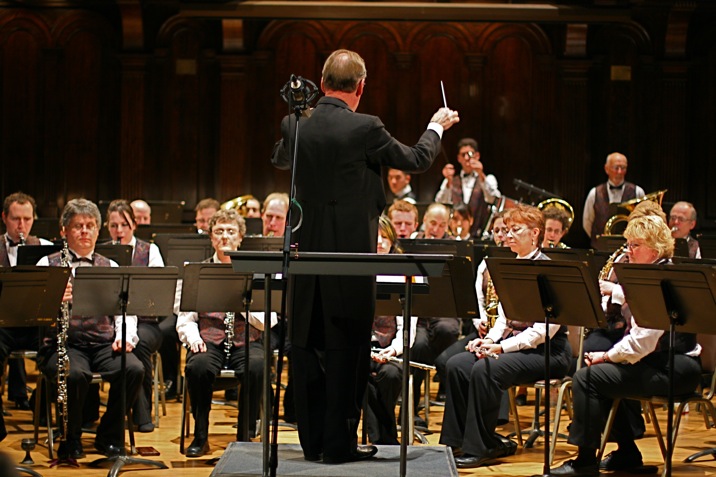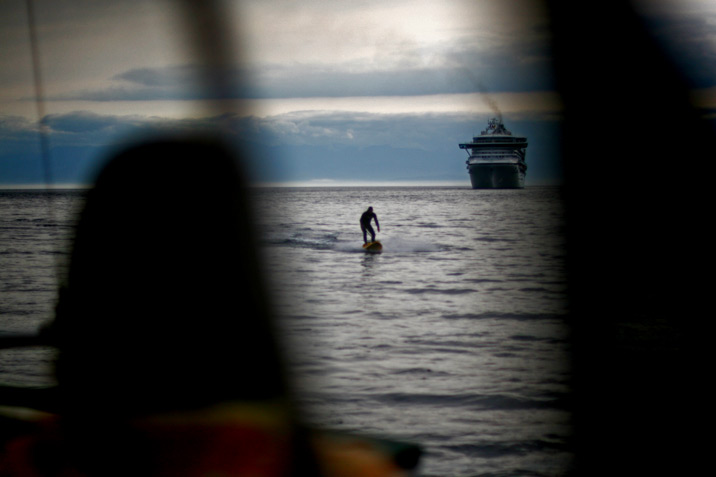
Last Friday I saw Nine Inch Nails at the Memorial Arena. I have been a fan since a highschool friend named Cyril Woon decided to put on Pretty Hate Machine in 1994, 5 years after it had come out. It must have been 1994, because we were playing a card game that had just come out in 1993. I tried to come to terms with what I was listening to. Was it techno, was it industrial, was it metal, was it ambient ballads gone horribly wrong? At first I found his voice annoying, not because it sounded annoying, but because it sounded like an ordinary person who was just really pissed off. What was remarkable about that? Why were we listening to it?
The answer was in the futuristic production and artistic focus. Trent Reznor had a drive to make something different, something raw – heavily produced, but not over-produced to the point where there was no musical agility anymore. The notes, the sounds – they were swings of an axe to a fragile wall of pop music. No apologies were made about the negativity in lyrics or tone for the next album I listened to, because it was about to get darker, more abrasive, and twisted.
But before I get to that 3rd album, I just want to mention Broken and Fixed. Looking at this now, this is the kind of artistic production that I’d really be into if I came across it now. Broken was a new album, the new one after Pretty Hate Machine, and Fixed was a remix album of that music. It never stuck for me, perhaps because I didn’t know much about it or it just didn’t get any play – I knew people that had it but for some reason it didn’t make it into the CD player nearly as much as Pretty Hate Machine or the next album. Perhaps it was the absence of Flood – who had engineered PHM and TDS – that made it stick a little less for me.
The Downward Spiral was a sinister, abrasive and scathing album from Nine Inch Nails. There was something even less innocent about The Downward Spiral – sonically it had been distorted, shredded, sandpapered down, and annihilated. The textures were intense, and even influential for me as a producer over a decade later. The rawness of Nine Inch Nails had hit a deeper level, and there was no going back. There was something about it that made you crave the self-destructiveness of this character. It was deliberately set up this way. Although I still really liked Pretty Hate Machine, I could not listen to it back to back after The Downward Spiral. The order would have to be reversed or else it was just The Downward Spiral. Pretty Hate Machine seemed too shiny in comparison. If you read the wikipedia article about where it was recorded, it makes sense. I have to credit my friend Joel for introducing me to this album. If he had a place on the Internets, I’d totally link to him.
After that I bought Further Down The Spiral – a remix album of the previous, and it was just a bit too indulgent for me in that area so I didn’t listen to it much. I wanted something new and found it in the rave scene at the time, and then lost track of all Nine Inch Nails and all pop music for that matter. Trance had brought me out of the musical haze of the early and mid nineties. That was it – I had caught The Perfect Drug on Much Music, but I wasn’t interested enough any more to buy the albums.
Earlier this year, I had not bought anything further by Nine Inch Nails until I came across the double CD for Ghosts I – IV at Lyles Place downtown. Ghosts has been its own marketing success story, having been available for a free download, or a purchasable double CD, or a deluxe version, or a vinyl version, or a limited edition deluxe edition for $300. Basically you get to choose how much you like Nine Inch Nails, and the options are there for you. The box sets reportedly sold out very fast. There might be some lessons for Warner, EMI, Sony and Universal here.
Ghosts itself is a double album of instrumental industrial music and some ambient tracks as well. I am not going to lie – I was pleased to be listening to Nine Inch Nails again. There was this whole dimension of music that I appreciated and it had been absent from my playlist for a very long time, something like a decade. In that time, I had developed my taste for instrumental music, most of electronica fitting into this category, and I had spent a lot of time myself doing sound design and sculpting audio textures for my own music. I instantly recognized some of the synths used on the album, even some in common with LSG’s “The Singles Reworked,” one of the best electronic albums I own. Like BT’s “This Binary Universe,” it marks a significant artistic progression with little or no regard whatsoever to what is popular or mainstream. It is a creative milestone for Nine Inch Nails, pushing the boundaries of what is acceptable once again.
That is my background with Nine Inch Nails.
lights in the sky
We went to Memorial Arena in half disbelief that someone in Victoria had actually booked an artist that wasn’t far, far, far past their prime. No hack on Victoria, but we’re a small market at best and we just don’t have the numbers to attract the bigger tours. This might not have been a turning point for the city, but for once it didn’t feel like an isolated town on an island, living 10-20 years artistically behind the rest of North America’s performing arts. It’s just a fact of being a small market on the way to no major cities or regions. We are literally on the edge of the earth. What I am saying is that, in that context, it made this show a little more special for me.
The rock brand was very prominent as you can see in the photo at the top of this post. There aren’t too many logos for bands or groups that have quite the strength of the Nine Inch Nails logo. It’s stayed the same as long as I can remember. It is simple, memorable and distinctive. I have seen quite a few rock band logos that are not even logos, but rather illustrations that have been used in place of a real logo. That’s fine – that is part of the culture. However, half of the music business is marketing and advertising, and so it is auto-inhibitive to prematurely discount brand equity. There are not too many groups with an identity as strong as we see with this band. Before the show started, the merchandise machine was in full swing – it’s business time.
At the start of the show, as seems to be the way bands like to do things, Nine Inch Nails came out and started rocking out really, really hard. Beck did this when I saw him at the Royal Theatre recently – and this wasn’t Beck’s forte, but it was definitely Nine Inch Nails’. Since I didn’t know some of the newer songs, I had to resort to appreciating the musicianship and the visuals.
The lead guitarist was head-banging so hard during his solos, I am not even sure how he was able to stand up while playing. I could say this or that about the rest of the band, but Trent Reznor really stole his own show, playing keyboards, glitchy touch-screen computer instruments, drum machines, piano-keyboards, xylophones, almost all of which he threw off the stage when done with. It became really clear early on that the band was not phoning this one in – they were there to put on a performance AND a show.
The visuals, let me say this first: it’s really hard to explain it and make it sound awesome, because as soon as you explain something like this, it takes some of the excitement and mystery away – not unlike explaining a magic trick before doing it. Suffice to say, their choice of visuals to sound were very deliberate and it showed throughout the night. This was not pyrotechnics or an intelligent lighting bonanza. This was a full media experience that was entirely based on the music. Sometimes they were in front of a desert scene, sometimes a swamp, sometimes they were behind or in it, sometimes they were interacting with the visuals in ways that complemented what they were doing musically. Sometimes the visuals were just there in the background, a city smoldering from its own need in the distance. Other times the visuals were based on the music videos for the song, but with real-time effects on a much larger screen. Or they would disappear behind a wall of static, bursting holes in it with notes from their instruments or words into microphones. It was intense.
Here’s the set-list Nine Inch Nails played in Victoria:
- 999,999
- 1,000,000
- Letting You
- Discipline
- March of the Pigs
- Head Down
- The Frail
- The Wretched
- Closer
- Gave Up
- The Warning
- Vessel
- 21 Ghosts III
- 28 Ghosts IV
- 19 Ghosts III
- Piggy
- The Greater Good
- Pinion
- Wish
- Terrible Lie
- Survivalism
- The Big Come Down
- 31 Ghosts IV
- Only
- The Hand That Feeds
- Head Like A Hole
Encore:
- Echoplex
- The Good Soldier
- God Given
- Hurt
- In This Twilight
All the “Ghosts” numbers you see above are instrumental tracks from the new album. They’re fairly left-field for the kind of mainstream audience Nine Inch Nails has these days, which means that some people were confused by the new material, and some others had the door opened for them to broaden their taste. As a DJ I can relate to how hard it can be to break relatively new or experimental music into the masses, and the Ghosts material fits both those categories. Not everyone is ready for it, but sometimes that kind of material can be the most important for the performer to play. Not only is it important for the artist and the sophistication of the listener, but some of it can be really, really good. For a concert and an audience with no shortage of attitude, for me, the Ghosts pieces were an oasis of composition, performance, and completely immersive artistry. It was a treat from the studio – songs that were never meant to be played out. I am so glad I got a chance to see those tracks performed despite all the forces against them.
The most interesting part of the Ghosts pieces were the placement in the set – if I was making a set listing for a band, I would arc the intensity in a similar way I think. Starting hard, moving into catchier tracks, then slowing it down to Ghosts levels before ramping the energy back up towards the finale, with one valley towards the end. At no point did I feel like the energy was dragging or that things were out of place. It was carefully done, and I understand that they take this aspect of their performances very seriously. As Reznor told Rolling Stone during rehearsal for the Lights in the Sky tour, “I think too much about this [bleep].” Well, we appreciate it.
At some point I’ll have to clarify the difference I see between a show and a performance. Someone who is technically very good can put on a good performance, despite other factors. Someone who is not so technically focussed can still put on a good show – and their fans are still happy to pay $200 to see them in concert, even when they do not display that they even want to be performing. This, to me, is sad, because while a show can be quite good, the performance can still be lackluster. Nine Inch Nails did not have this issue. I hope that makes sense.
Every now and then you come across something that forces you to re-evaluate how you judge a certain category of things – be it a book of fiction, a DJ set, a movie, or simply a dinner at a restaurant. After one of these experiences, you can’t be satisfied so easily with what came before it. This show AND performance was one of those experiences which raises the bar for all future concerts.
It was well worth the $55, and a new benchmark to determine value of all other concerts with.






